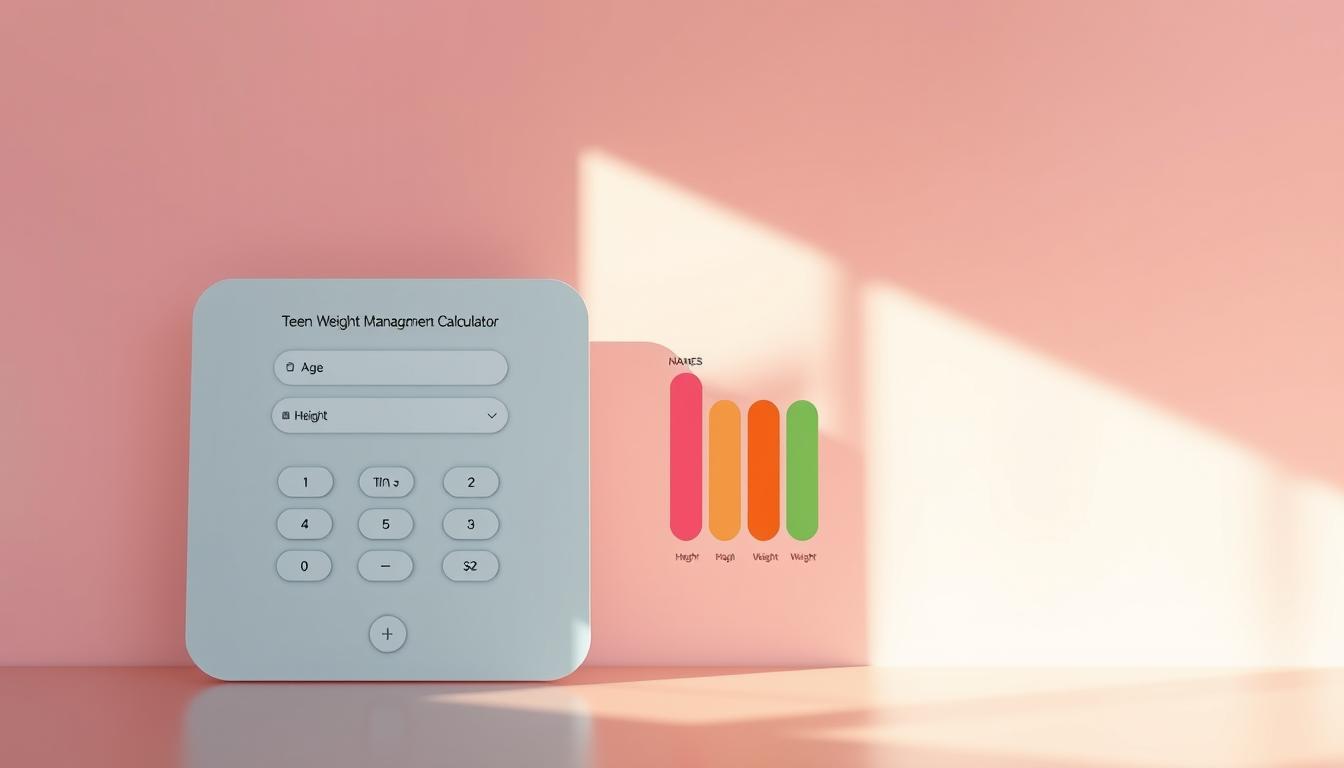“The greatest wealth is health,” said Virgil, a Roman poet. This timeless quote emphasizes the importance of maintaining a healthy lifestyle, especially during the crucial teenage years.
As teenagers grow and develop, their bodies undergo significant changes. Maintaining a healthy weight is vital for their overall health and long-term well-being. Our weight management calculator is specifically designed for teens, taking into account their unique growth patterns and energy needs.
Using our calculator, teens and parents can make informed decisions about weight management. It provides an estimate of a teen’s energy requirement, which is essential for supporting growth and development. For more information on BMI and weight loss strategies, you can visit our page on BMI weight loss strategies.
Key Takeaways
- Our calculator is designed specifically for teens, adjusting for differences in height, age, and sex.
- Maintaining a healthy weight during teenage years is crucial for long-term health outcomes.
- The calculator estimates a teen’s energy requirement to support growth and development.
- Healthy weight management for teens focuses on supporting growth, not restrictive dieting.
- Using a specialized tool like our calculator helps teens and parents make informed decisions.
Understanding Teen Weight Management
Understanding weight management in teenagers is crucial for their overall health and development. Teenage years are marked by significant physical, emotional, and psychological changes, making weight management a complex issue.
During adolescence, body composition naturally changes, and growth patterns vary significantly among individuals. As stated by health experts, “BMI categories for children and teens are based on sex- and age-specific BMI percentiles.”
Why Weight Management Matters for Teenagers
Weight management is vital for teenagers because it affects their overall health and well-being. Being overweight or underweight can lead to various health issues, including diabetes, cardiovascular diseases, and mental health problems.
Maintaining a healthy weight during adolescence is crucial for preventing long-term health issues and promoting a positive body image.
The Difference Between Teen and Adult Weight Calculations
Teen weight calculations differ significantly from adult calculations. Teenage weight assessments must account for age, sex, and height in ways that adult calculations do not.
Unlike adults, where BMI is calculated using a fixed number, teenagers’ weight status is evaluated using percentiles. For instance, being in the 75th percentile means that a teenager is heavier than 75% of their peers and lighter than 25%.
How the Weight Management Calculator for Teens Works
Our weight management calculator for teens is designed to provide personalized guidance by considering various factors that influence a teenager’s health and wellbeing.
The calculator uses a combination of metrics, including BMI percentiles, estimated energy requirements, and activity levels, to offer a comprehensive assessment.
BMI Percentiles and Z-Scores Explained
BMI percentiles are a critical measure for assessing weight status in teenagers. They compare a teen’s BMI to others of the same age and sex, providing a more nuanced understanding than BMI alone. Z-scores further refine this by indicating how many standard deviations a teen’s BMI is from the mean.
Estimated Energy Requirements (EER)
Estimated Energy Requirements (EER) are calculated based on factors such as age, sex, weight, height, and activity level. EER represents the average dietary energy intake needed to maintain energy balance. Our calculator uses EER to provide guidance on daily calorie needs.
Activity Levels and Their Impact
Activity level significantly impacts energy requirements and weight management. We categorize activity into four levels: inactive, low active, active, and very active. Each category reflects the intensity and duration of daily physical activities.
| Activity Level | Description |
|---|---|
| Inactive | Mainly sitting. Spends most of the time in low intensity activities. |
| Low Active | Mainly standing. Spends less than one hour a day in low to moderate activities. |
| Active | Moderate increase in heart rate and some light sweating. Spends at least an hour a day in moderate activities. |
| Very Active | Substantial increase in heart rate and heavy sweating. Spends more than one hour a day in high intensity activities. |
Understanding and accurately assessing a teen’s activity level is crucial for effective weight management and overall health.
Using the Calculator: Step-by-Step Guide
Navigating our weight management calculator is easy when you follow our simple, step-by-step instructions. To ensure you get accurate and useful results, we’ll guide you through the process of inputting your information, understanding the units of measurement, and submitting your data to receive your personalized results.
Required Information to Input
To calculate BMI percentiles and Energy Requirements accurately, all fields must be filled out correctly. This includes entering your age, sex, weight, height, and activity level. It’s crucial to input accurate information to get reliable results. Our calculator is designed for teens aged 2-20 years for BMI Z-scores and 3-19 years for Energy estimates.
- Age and sex are necessary for determining the appropriate growth charts and energy needs.
- Weight and height are used to calculate BMI and assess weight status.
- Activity level helps estimate daily energy requirements based on your level of physical activity.
Understanding the Units of Measurement
Our calculator allows you to input your height and weight in various units, making it convenient for users familiar with different measurement systems. You can enter your weight in pounds or kilograms and your height in feet and inches or centimeters. Ensuring that you select the correct units for your inputs is vital for accurate calculations.
Submitting and Getting Your Results
Once you’ve entered all the required information, simply click the “Calculate” button to receive your results. Our calculator will process the data and provide you with your BMI percentile, Z-score (if applicable), and estimated energy requirements. You can then review your results to understand your weight status and daily energy needs. You have the option to save or print your results for future reference or to share with a healthcare professional.
Interpreting Your Calculator Results
Once you’ve used the weight management calculator for teens, understanding the results is crucial for making informed decisions about your health. The calculator provides a comprehensive report that includes BMI categories, percentiles, and energy requirements based on your activity level.
BMI Categories for Teens
The BMI category for teens is determined by comparing their BMI to a growth chart that accounts for age and sex. The categories are:
- Underweight: BMI below the 5th percentile
- Normal weight: BMI between the 5th and 85th percentiles
- Overweight: BMI between the 85th and 95th percentiles
- Obese: BMI at or above the 95th percentile
Understanding your BMI category helps identify potential health risks associated with your weight.
Understanding Percentiles and What They Mean
Percentiles are used to compare your teen’s measurements to those of others of the same age and sex. For instance, being in the 50th percentile for BMI means your teen is at the average weight for their age and sex. Being above the 95th percentile or below the 5th percentile may indicate a need for further health assessments.
Energy Requirements Based on Activity Level
Energy requirements are calculated based on your teen’s activity level, which is categorized as inactive, low active, active, or very active. The energy needs vary significantly across these categories:
- Very Active: More than 1 hour of high-intensity activity daily, requiring a substantial amount of calories.
- Active: At least 1 hour of moderate activity daily.
- Low Active: Less than 1 hour of low to moderate activity daily.
- Inactive: Mostly sitting with low physical activity levels.
Adjusting calorie intake according to the activity level ensures that your teen’s energy requirements are met, supporting healthy growth and development.
Healthy Weight Management Strategies for Teens
Healthy weight management strategies are essential for teens to ensure they develop good habits that last a lifetime. By focusing on balanced nutrition and appropriate physical activity, teenagers can maintain a healthy weight and improve their overall health.
Balanced Nutrition for Growing Bodies
A balanced diet is crucial for teenagers as their bodies undergo significant growth and development. Ensuring they consume a variety of foods rich in nutrients, such as fruits, vegetables, whole grains, lean proteins, and healthy fats, is vital. Parents can help by making small changes in their family’s diet, such as reducing sugary drinks and increasing the intake of whole foods.
We recommend plotting a child’s BMI on the proper CDC growth chart to monitor their growth patterns and make informed decisions about their diet and physical activity habits.
Appropriate Physical Activity Guidelines
Regular physical activity is a key component of healthy weight management. Teens should aim for at least 60 minutes of moderate to vigorous physical activity daily. This can include a mix of aerobic exercises, muscle-strengthening activities, and bone-strengthening exercises. Encouraging teens to find activities they enjoy can help make physical activity a sustainable habit.
| Activity Type | Examples | Benefits |
|---|---|---|
| Aerobic Exercises | Running, cycling, swimming | Improves cardiovascular health |
| Muscle-Strengthening Activities | Weightlifting, bodyweight exercises | Builds muscle mass and strength |
| Bone-Strengthening Exercises | Jumping rope, gymnastics | Enhances bone density |
Tracking Progress Over Time
Monitoring progress is vital to maintaining a healthy weight. We suggest regular check-ins to track changes in weight, BMI percentiles, and overall health markers like energy levels and sleep quality. Using the weight management calculator as one tool among many can help identify trends and patterns that may require attention.
By focusing on non-scale victories and overall health improvements, teens can develop a more positive relationship with their weight and health.
Making Weight Management a Positive Experience
To make weight management a positive experience for teens, we must emphasize the importance of health over appearance. Parents play a significant role in shaping their child’s habits and attitudes towards food, exercise, and body image. By making small changes in their family’s diet and physical activity habits, parents can help their child avoid developing weight problems.
It’s essential to approach weight management in a way that promotes positive body image and self-esteem. We should focus conversations on health rather than appearance or specific numbers on the scale. Recognizing and avoiding potentially harmful diet culture messaging that targets teens is also crucial.
Making healthy eating and physical activity enjoyable family activities can help teens develop a positive relationship with food and exercise. By handling setbacks and challenges without discouragement or negative reinforcement, we can create a supportive environment that fosters overall wellbeing and development.
As a valuable resource, the weight management calculator can help teens and parents track progress and make informed decisions. However, it’s essential to use this tool as a positive resource rather than a source of stress or judgment. By modeling healthy behaviors and attitudes about food, exercise, and body image, parents can help their teens achieve a healthy weight and maintain a positive self-image.
Ultimately, healthy weight management during adolescence is about supporting overall wellbeing and development, not achieving a specific appearance or number. By working together and seeking professional help when needed, we can help teens develop a positive and healthy relationship with their bodies.


